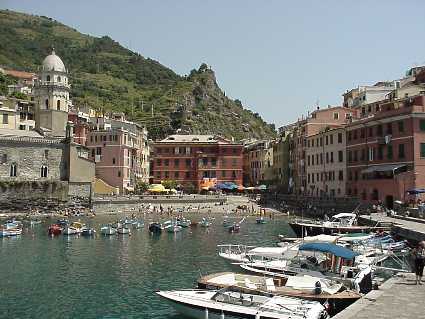 |
 |
 |
The Cinque Terre (five lands) include five villages that retain their charm largely due to their isolation. For much of their existence, they were only accessible by sea, because of the steep mountains behind them. In the past, they survived through fishing and some agriculture, primarily wine-making on the terraced slopes. The towns are Riomaggiore, Manarola, Corniglia, Vernazza, and Monterosso al Mare.
 |
Of the five Cinque Terre towns, Vernazza is the only one with a small harbor and a beach. The street is lined with shops and restaurants, and tourism has undoubtedly become the primary engine of its thriving economy. |
|
Riomaggiore has embraced the notion of protecting the natural beauty of the land. The village serves as the headquarters of the Cinque Terre National Park and houses an Environmental Awareness Center. The famed seaside Via dell'Amore or Lovers' Walk to the next village Manarola was washed out in the winter and was being repaired the day we visited. The harbor is so small that fishermen need to store their boats on land. The street approaching the village is lined with fishing boats, which can be launched on the ramp that goes down to the harbor. Notice, too, the old ramparts of the protecting wall, a feature of nearly every place we have visited this season. |
|
|
Corniglia is inaccessible even by ferry, although it is possible to visit on foot or by train. It is known especially for 2,000 year old wine production. Notice the terraced hills behind the village where grapes are grown. Amphorae* with the name Cornelia were found during the excavation of the ancient destroyed village of Pompeii in southern Italy. * Amphorae are ancient urns used to transport products; see a photo of some we saw in Provence. |